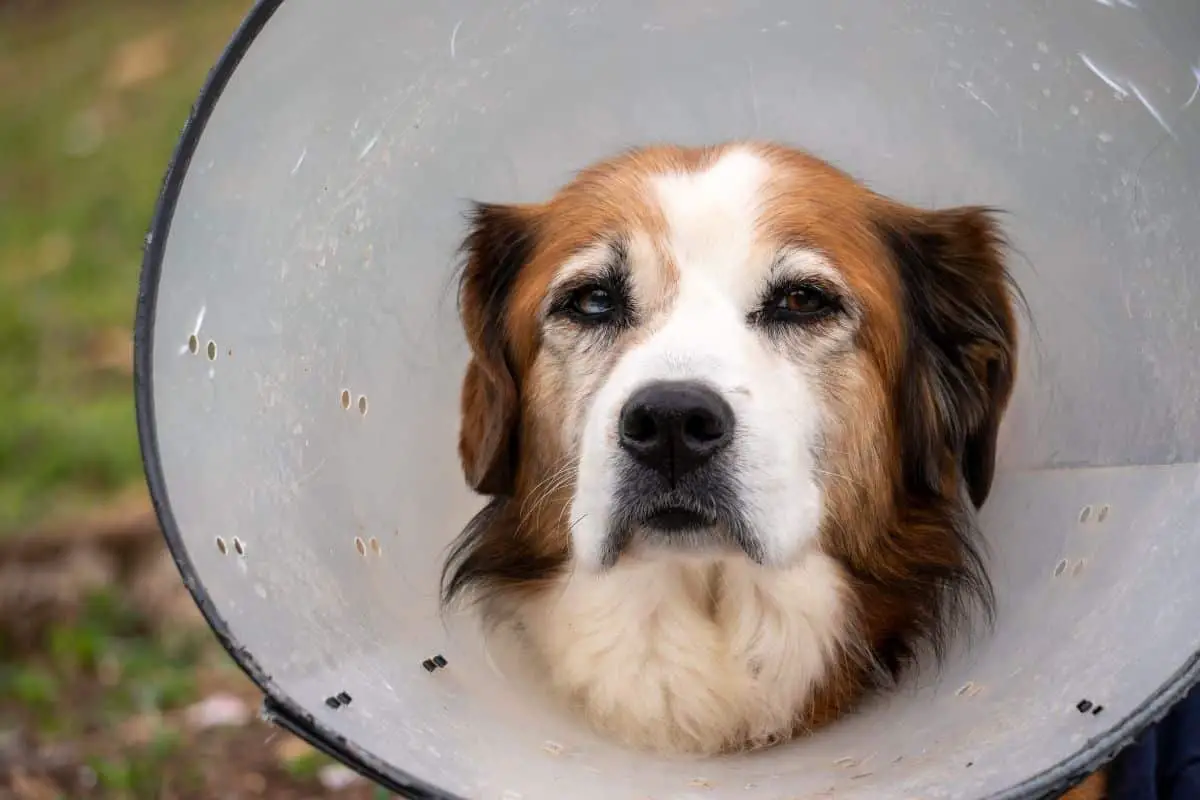Your dog may not have seen Disney Pixar’s Up, but they are certainly familiar with the concept of the cone of shame.
They keep trying their best to get out of the plastic cones that you have placed around their neck after their neuter surgery.
These cones are of course put in place to stop your dog from licking at their wounds after surgical procedures. If your dog were to do this and break their stitches, this will of course affect the healing process.
However, seeing as your dog is determined to free themselves from the cone of shame, it can be a struggle to keep it in place.

It may also make things a little impractical such as taking them for a walk, or leaving them alone to sleep in their basket. So how many days after surgery does your dog still need to have the cone in place to stop them licking their wounds?
Today we’re going to cover everything you need to know about your dog and their protective cone.
You will essentially need to time this so that the healing period has a chance to pass, and so that the neuter skin incisions have a chance to heal. This recovery period is of course important for a healthy and happy hound.
So let’s take a look at everything you need to know about your dog and their cone!
How many days after neutering can I take the cone off?
The general rule of thumb when it comes to dogs and their traditional cone is to keep it on for around 10 days after surgery has finished. This will give your dog’s abdominal incision time to heal properly.
The first few days post surgery are of course the most essential, as if your dog were to chew with their stitches and remove them, it could cause more issues.
If you notice that your dog keeps doing this, make sure to look for signs of infection. You may need to take them back to your vet if they continue to try to interfere with their wound.
If your pet really can’t stand to have the traditional cone around their neck, there are also cone alternatives that you can use. These cone alternatives include soft collars, recovery jackets, or inflatable collars.
Soft collars are basically the same style as traditional cones, only made from a softer material that won’t be as irritable for your dog.
Make sure not to opt for soft collars that are too soft, though, as these won’t function as you need to. Other alternatives to traditional cones of course include an inflatable collar, which work much in the same way.
However, these can be easily punctured.
If your dog is adamant about not having anything around their neck, then a recovery jacket will be the way to go.
This works exactly like an item of clothing – your dog will need to wear this over their body, which will then protect their stitches.
Is your dog leaving their stitches and wounds alone? Then you won’t need to worry about using an alternative to a traditional cone. If 8 days have elapsed and your dog is happy enough, then you can then remove the cone of shame without any hassle.
How long should a dog not lick after being neutered?
The whole point of the dog’s cone is of course to prevent them from licking their wounds after their surgery. No licking is allowed whatsoever, as this can hamper the healing process.
It will be especially important in the first few days after their surgery. If your dog were to nibble at their stitches, this could cause them further injury. Constant licking can also cause a bacterial infection, which we’re sure you want to avoid.

To avoid any further complications, it will be best to keep their cone in place for between 7 and 10 days so that the wound has a chance to heal.
If your pet is clearly very irritated by this, it will be worth consulting with your vet to see if they have any advice. Constant discomfort could be a sign of a bigger issue which will need to be dealt with sooner rather than later.
How do I know when a neuter incision is healed?
It should be fairly easy to see when your dog’s neuter incision has healed. You will notice that the edges of the incision have closed, and are no longer red and angry.
Instead, the skin surrounding the site of the incision will be pink, which is a clear sign that the cut is healing up nicely. There may even be some bruising around the site where the incision was made.
If you notice any discharge or swelling around the site a couple of days after surgery, this could be a sign that something isn’t quite right. In this case, you will need to take your pet back to the vet so that they can examine the wound.
They will then be able to advise you as to the next course of action to get the wound healing up nicely.
It’s very unlikely that this will happen, however, if your dog is prevented from licking the incision.
Depending on the stitching that was used for the surgery, you may need to take your pet back after a few days for these to be removed.
The vast majority of vets these days will use dissolvable stitches that will fall out on their own once the wound has healed up nicely. If there are any complications though, you will of course need to take your dog back to the vet.
What happens if my dog licks his incision?
This is what we want to stop from happening of course. This is because if your pet were to be left to their own devices and kept licking away at their wound, they could either pull the stitches out, or infect the wound.
Dogs have a whole load of bacteria in their saliva, which is why you need to head to the ER if you were ever bitten by one and their teeth break the skin.
So if these bacteria were introduced to your poor pet’s sore spot after surgery, it could complicate things. The bacteria could cause an infection which would then hamper the healing process, and would mean your pet has to wear their protective cone for even longer.
It will be best to check your pet’s incision at least twice a day after surgery. This allows you to better monitor how things are going, especially if your pet keeps trying to insistently lick at it.
Can my dog sleep in a cone?
Yes, your dog can sleep quite comfortably in a cone. Even though it may be a little awkward for your pet at first, they will easily be able to adjust for the few nights that they will be required to wear a cone for.
Make sure to check their wound first thing in the morning to make sure that it’s doing okay. It will also be worth checking how secure the cone is on your dog’s neck to ensure that they haven’t tried to remove it during the night.
It may seem a little strange to leave the cone on when your dog is sleeping, however, this will be essential for protecting their stitches.
If you don’t trust your pet to be left alone at night with their cone on, in case they try to remove it, it may be best to opt for a cone alternative. In this case, either a soft collar or recovery jacket will be your best bet.
The recovery jacket will be worn like a jumper, and it will effectively prevent your pet from licking at the wounds at all.
In summary
So there you have it! You now know that you should leave your dog’s cone on for around 10 days.
If your dog is happy enough and leaves their stitches alone, then you can even remove it early after 8 days, providing that the healing process is progressing well.
If your dog keeps trying to lick their wound, then they will need to continue wearing the cone for at least 10 days.
If your dog is being a nightmare and constantly trying to remove the cone, it will be worth opting for a cone alternative so that their wound will stay protected and have a chance to heal.
You can either opt for a soft collar, an inflatable collar, or even opt for a recovery jacket instead. These will be less irritating for your pet, and will hopefully give their wound the time it needs to heal.
Notice any signs of infection after the 10-day period or has your dog managed to interfere with their stitches? Then it will be time to take them back to the vet so that they can help you to tackle the situation.
- What Dog Breeds Have Pink Skin? - March 24, 2023
- What Are the Most Inspiring Dog Breeding Quotes? - March 20, 2023
- Can Pheromone Spray Help Improve Dog Breeding Results? - March 19, 2023








